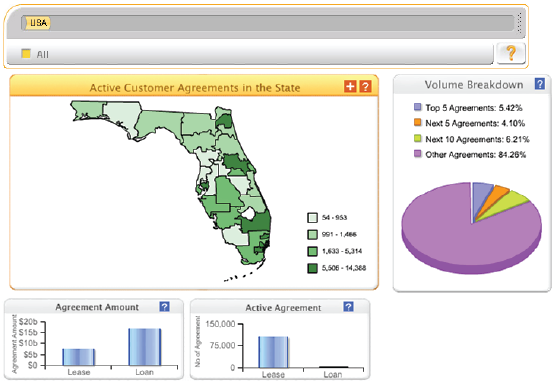Our customer is a $25 billion revenue subsidiary of a Fortune 100 company. This subsidiary provides commercial finance through a variety of business units.
Our customer, the Financial Services subsidiary of large Fortune 100 company, was faced with the need to integrate its decision making across multiple systems, geographies, product offerings, acquired loan portfolios etc. Having grown over the previous decade to becoming a major profit engine for the entire enterprise, the Financial Services arm was now tasked with increasing incremental profitability and reducing risk across its entire portfolio.
One result of the enormous diversity of operations and systems was the absence of shared data infrastructure which could be used for analysis and decision making. The company decided that it needed to invest in a multi-year Data Warehousing initiative to create this foundation which would also act as an integration point for reporting on any future loan portfolio acquisitions.
Techlogix was tasked to assist on all aspects of the Data Warehouse including Architecture and Data Modeling, data extraction and loading and reporting and analytics.
The Challenge
Our customer needed to integrate its Business Intelligence/Data Warehousing initiatives that had been developedindependently in seven different business units. Additionally, a profusion of data marts made enterprise level analysis of data extremely difficult. Our customer decided to invest a single Enterprise Data Warehouse built on the Teradata platform. However, the purchase of Teradata hardware was simply the first (and easiest!) step in implementing the Enterprise Data Warehouse.
The Solution
The project was initiated with a 4 person modeling team which included 2 architects from Techlogix. Using the Teradata Logical Data Model for Financial Services as a starting point, the modelers worked on created an enterprise representation of the Finance Corp’s key data. As portions of the data model were completed, additional ETL resources were added to the team to initiate the loading of data into the new EDW. This was followed by an a series of projects which implemented the creation of reports in Business Objects which duplicated an existing Oracle based reporting data mart. This served to validate the model and the reports generated from it.
After this initial validation, the team worked on adding additional functional areas to the data model most significantly including Siebel prospect data. In parallel a team of front end developers worked on Business Objects universes and reports to product end user facing reporting and analytics.
Over time, the consultant team migrated from a largely onsite Teradata team to substantially Techlogix lead team with significant development resources offshore. The offshore team was involved in ETL and front end development as well as providing production support and monitoring.
The Implementation Team
The Techlogix implementation team consisted of a number of resources working in all parts of the delivery lifecycle including Modeling, ETL and Front End development.
Key Contributions: Modeling
Some of the key contributions of the Techlogix team in modeling included:
- Modeling & Architecture
- Helped develop EDW roadmap and data architecture standards with Teradata Consulting
- Modeled key subject Areas (Party, Agreement & Events)
- Extended CFLDM reference model to include Siebel CRM
- Standards & Specifications
- Key role in establishing Modeling standards (naming & typing)
- Developed ETL Specifications Template for automated ETL Code generation
- Developed detailed ETL specifications for more then 10 source systems
- Data Quality & Model Management
- Helped identify data quality issues and launched Data Quality Initiative
- Managed Erwin Model Mart
Key Contributions: ETL
Some of the key contributions of the Techlogix team in ETL included:
- Developed ETL code using both Informatica (for pulling source data into stage) & Teradata BTEQ (for pulling stage data into EDW Core tables)
- Developed ETL routines for more then 10 source Systems (Siebel, Workflow, PMSVFS, ACBS, Strategy, RDM, GEODE & REM)
- Helped with Informatica Upgrade from 6.x to 7.x. for Prod, Dev and INTG environments
- Updated FACTO & GL ETL code to conform with EDW Standards
- Helped Develop ETL coding standards
- Helped Develop data validation standards and developed validation scripts for various source pulls
Key Contributions: Front End
Some of the key contributions of the Techlogix team in Front End development included:
- BusinessObjects Universe & Reports
- Developed 3 Universes to support to Analytics inCRM/Prospecting, Enterprise Marketing, Business Consistency Initiative & Financial Reporting
- Developed over 100 reports in various subject areas
- Upgraded BO platform to v6.5.1
- Dashboard
- Developed Dashboard Framework
- Deployed key sales metrics showing booked deals and pipeline across GECF
- Web based Reporting
- Developed Enterprise Sales Compass Application
- Developed AAA Data Tool to support business consistency initiative


Technology
The Enterprise Data Warehouse was developed using Teradata, Informatica and Teradata tools for ETL and Business Objects for reporting and front-end analysis.
Benefits
Data from four legacy systems maintained across three different reporting environments was consolidated into a single Teradata instance supported by 2 BusinessObjects Universes. The first two completed projects also allowed our customer to showcase its approach of integrating all enterprise data into the warehouse and establish a data model foundation to be used across the business.
This Business Intelligence initiative has provided a foundation for an analytics driven reinvention of key business processes including Sales Origination, Pricing, Risk Assessment and Profitability Analysis. Previously all four aspects were the responsibility of separate departments which based their decision making on separately derived reports and data extracts which were often difficult to reconcile. By ensuring a single source for analytics across multiple departments, the true enterprise value and risk across the entire customer lifecycle was made consistent and visible resulting in significantly improved decision making.





